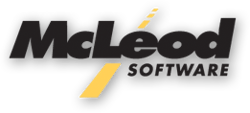Several times this week, I heard McLeod Software founder Tom McLeod lament that if he would’ve just been a little bit smarter, a little bit faster, the company could’ve achieved a lot more over the last 30 years.
But, given that McLeod Software’s sales revenue last year climbed 65% over 2013 (which was the company’s previous record high revenue year) and that 2014 was the fifth consecutive year of greater than 20% year-over-year compound annual growth, I’m thinking there might be some leg-pulling going on.
Indeed, at a table during a lunch break at this year’s McCloud Software Users’ Conference, a customer asked a couple of McLeod employees whether Tom was putting on an act with his informal, soft-spoken and humorous (yet substantial) opening presentation earlier in the day. (I myself had noted the contrast to many CEO Powerpoint sessions—scripted, rehearsed, and timed to the second.) Was he trying to hide how smart he must be, the customer wanted to know?
The employees smiled, but if they knew something they weren’t talking.
Following that presentation on coming challenges to freight transportation, McLeod sat down with a few trade editors to go over the company’s latest products, but the conversation turned instead to his business philosophy and evolution of the trucking industry since 1985.
“Not too many people have the foresight to start an enterprise like this in the 8th grade,” he joked, I think. “It was a good timing to start and we had some of the right customers that kept us focused and pointed us in the right direction through those early days.”
McLeod’s guiding principles are appropriately straightforward: Spend less than you take in, do what you say you’re going to do, know what you’re doing, and treat people with dignity and respect.
Of note, only the first principle has any wiggle room.
“A lot of times in customer service you’ve got to set that rule aside for a specific situation,” he said. “If you’ve made a commitment, the commitment is more important—so you’ve got to be very careful and make sure you make commitments you can deliver on.”
And that brings us to trucking. In his earlier presentation, McLeod stressed the importance of carriers knowing their true costs and setting rates accordingly. Yet too many still are “just guessing.” How does this happen, and how does transportation management software help?
“Pricing discipline is stopping to take enough time to understand your costs and your margin requirement. So if we can shorten the amount of time it takes to get to a good decision point, that helps enormously for the carrier to make the right decision,” McLeod said. “In the past it was guess work. A lot of carriers just got comfortable with trying to get some clue of what everybody else was charging, or have the shipper tell them. And they figured, ‘if they can make it at that, I guess I can too.’”
“I think of it as the ‘adolescence’ of the deregulated marketplace,” he said. “People were able to operate off of a hunch and being able to spec their trucks correctly.”
So what was the problem that early McCloud Software products were supposed to solve for trucking companies, 30 years ago?
“They were just looking to stop buying so many typewriters,” he quipped. But the reality was very serious: The more trucks in the fleet, the more people a carrier needed to type the freight bills and process driver pay and paperwork. Holding a legal pad, McLeod joked that once a fleet grew to more than 25 trucks (the number of lines of a sheet of paper) they were potential customers because there was no longer enough room on the page.
Simply, his software was designed to automate mundane tasks. Again using the legal pad, he quickly sketched the rudimentary flow chart he used to pitch the service to trucking companies: Essentially, the load info had to be entered only once and all the data would be available for both billing and payroll, and any subsequent processing.
Then along came EPA emissions regulations for truck engines, and everything changed. Through the 2000s, new equipment became more complex, more expensive and less efficient. Fuel prices began to fluctuate. And then the recession hit, forcing carrier executives to squeeze every penny per mile in costs.
And fleet management software has had to keep up with that growing complexity.
“In the last 10 to 15 years we’ve really seen management maturity come about. The companies that are surviving and thriving in the marketplace are doing much less shooting from the hip,” McLeod said. “If you want to thrive in the long term, you’ve got to understand your costs and your rates, your network, and how changes will impact that.”






